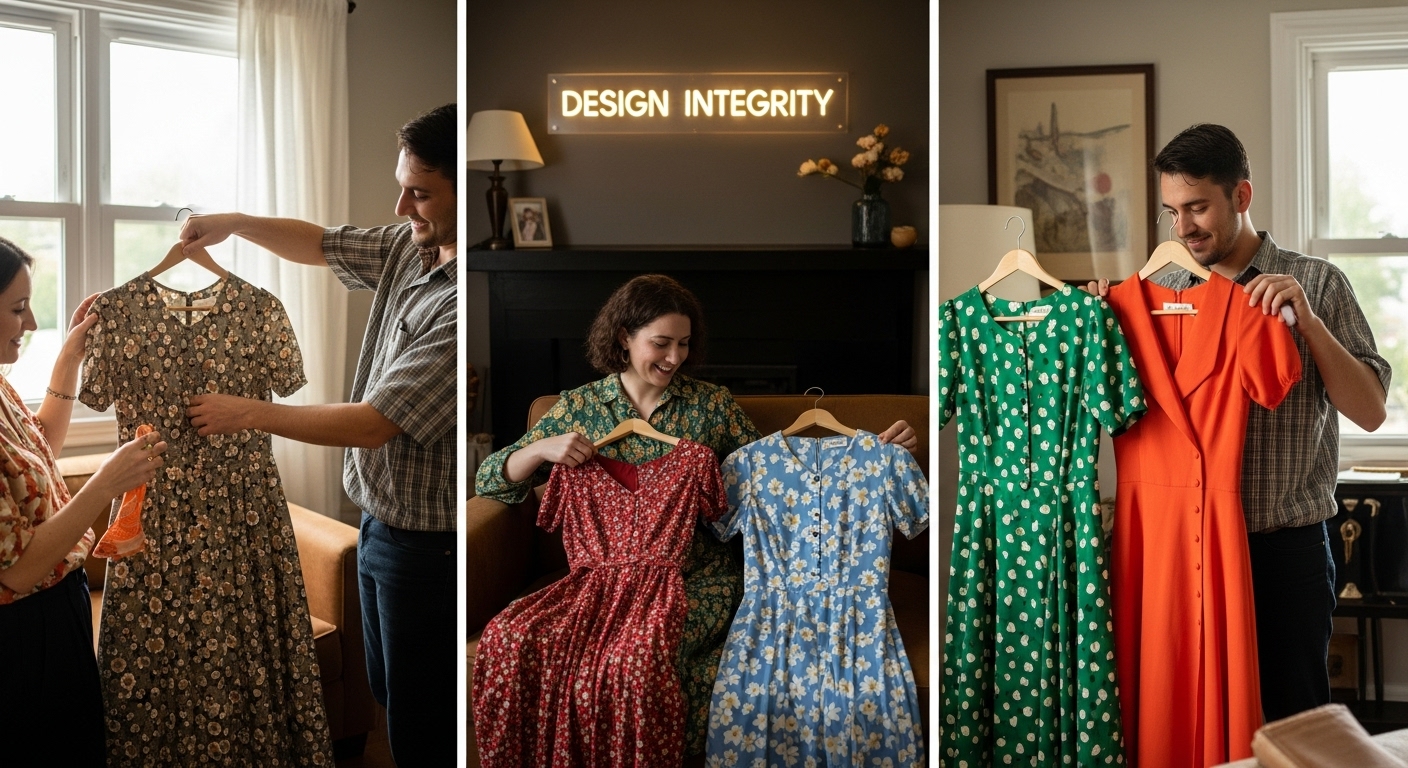Understanding Vintage Dresses: A Comprehensive Guide
- Emma

- Sep 19
- 8 min read

Vintage dresses capture far more than fleeting fashion trends. These garments are true historical artefacts and some are even over 100 years old, making them time capsules stitched with the stories of their eras. Yet what surprises most is this. The real allure of vintage dresses goes far beyond style or nostalgia. Their craftsmanship, materials, and cultural meaning reveal bold truths about changing society, artistry, and sustainability in ways that modern clothing never could.
Table of Contents
Quick Summary
Takeaway | Explanation |
Vintage dresses are authentic historical garments | Vintage dresses are unique pieces ranging from 20 to 100 years old, showcasing the styles and craftsmanship of their time. |
Preserve vintage dresses with proper care | Maintain temperature, humidity, and light exposure to protect delicate fabrics and construction from deterioration. |
Vintage clothing promotes sustainability | Choosing vintage reduces waste and environmental impact by extending the life cycle of garments and conserving resources. |
Study design characteristics of different decades | Each era has distinct styles that reflect cultural and social changes, helping identify authentic vintage pieces. |
Collecting vintage dresses requires knowledge | Understanding textile care and preservation techniques is essential for maintaining the historical significance and beauty of collected garments. |
Defining Vintage Dresses and Their Characteristics
Vintage dresses represent more than mere clothing items; they are living historical artefacts that encapsulate the aesthetic, social, and cultural narratives of specific eras. These remarkable garments carry stories woven into their fabric, silhouettes, and intricate design details that transcend contemporary fashion trends.
The Essential Definition of Vintage Dresses
A vintage dress is traditionally defined as an authentic garment originating from a previous historical period, typically ranging between 20 to 100 years old. Unlike contemporary reproductions, genuine vintage dresses are original pieces crafted during their respective time periods. Experts at the Victoria and Albert Museum categorise vintage clothing as items representing the design, construction, and style characteristics of their specific era.
Key characteristics that distinguish authentic vintage dresses include:
Construction Quality: Handmade or meticulously tailored garments with superior craftsmanship
Fabric Authenticity: Original textiles representative of the period’s manufacturing capabilities
Design Integrity: Silhouettes, cuts, and embellishments unique to specific decades
Historical and Cultural Significance
Vintage dresses serve as tangible representations of fashion evolution, reflecting societal changes, technological advancements, and cultural movements. Each dress tells a narrative about the social norms, economic conditions, and aesthetic preferences of its time. From the structured, corseted designs of the early 20th century to the liberated, flowing silhouettes of the 1970s, these garments provide invaluable insights into changing female experiences and expressions of identity.
For those interested in expanding their understanding of vintage fashion, read more about vintage design influences and how historical contexts shaped clothing styles. Understanding vintage dresses means appreciating them as more than just clothing – they are historical documents that communicate complex social narratives through their design, fabric, and craftsmanship.
The Importance of Vintage Dresses in Fashion History
Vintage dresses are far more than nostalgic garments; they represent pivotal historical documents that chronicle societal transformations, technological innovations, and cultural movements through textile and design narratives. These remarkable pieces encapsulate complex stories of femininity, social progress, and artistic expression across different epochs.
Documenting Social Change Through Fashion
Fashion serves as a powerful lens through which we can understand historical social dynamics. Vintage dresses reveal profound insights into women’s evolving roles, economic conditions, and cultural expectations. From restrictive Victorian corsets symbolising societal constraints to the liberating silhouettes of 1920s flapper dresses representing emerging female independence, each garment communicates nuanced cultural narratives.
Key historical fashion transformations include:
Wartime Adaptations: Practical, utilitarian dress designs emerging during World War II
Economic Indicators: Fabric choices reflecting material availability and economic conditions
Social Mobility: Dress styles representing changing class structures and workplace participation
Preserving Artistic and Technological Heritage
Designers and historians recognise vintage dresses as intricate archives of manufacturing techniques, textile innovation, and aesthetic sensibilities. According to research from the Museum of London, these garments provide critical documentation of technological advancements in textile production, tailoring methods, and design philosophies. Each dress represents a microcosm of industrial and creative achievements from its respective era.
For enthusiasts eager to explore deeper connections between fashion and historical narratives, discover our curated vintage design collections that showcase the remarkable craftsmanship of different periods. Vintage dresses transcend mere clothing; they are living artefacts that connect us intimately with our collective cultural memory, offering profound insights into human creativity, social evolution, and artistic expression.
Sustainability and the Appeal of Vintage Clothing
Vintage clothing represents a powerful intersection between environmental consciousness, personal style, and sustainable fashion practices. Far beyond mere trend, choosing vintage garments has emerged as a meaningful strategy for reducing fashion’s ecological footprint and challenging the disposable nature of contemporary clothing production.
Environmental Impact and Ethical Consumption
The fashion industry is notorious for its substantial environmental burden, with mass-produced clothing contributing significantly to global waste and carbon emissions. Vintage clothing offers a compelling alternative by extending garment lifecycles, reducing demand for new textile production, and minimising the environmental strain associated with manufacturing processes.
Key sustainable advantages of vintage clothing include:
Waste Reduction: Preventing perfectly wearable garments from entering landfill systems
Carbon Footprint Minimisation: Eliminating the need for new manufacturing processes
Resource Conservation: Reducing water, energy, and raw material consumption
The Unique Value Proposition of Vintage Fashion
Beyond environmental benefits, vintage clothing presents an unparalleled opportunity for individual expression and style differentiation. According to research from The Conversation, second-hand and vintage fashion is experiencing a significant mainstream renaissance, driven by consumers seeking unique, high-quality pieces that transcend mass-market uniformity.
For fashion enthusiasts looking to explore sustainable style options, browse our curated vintage collection that embodies both ecological responsibility and timeless design. By choosing vintage, individuals make a powerful statement about personal values, celebrating craftsmanship, reducing environmental impact, and challenging the rapid consumption cycles of contemporary fashion industries.
Identifying Different Styles and Eras of Vintage Dresses
Understanding vintage dress styles requires a nuanced appreciation of historical context, fabric technologies, and social dynamics that shaped fashion across different decades. Each era presents unique silhouettes, design philosophies, and aesthetic expressions that reflect the cultural zeitgeist of its time.
Defining Decade-Specific Dress Characteristics
Vintage dresses are more than aesthetic objects; they are complex historical narratives captured through textile design, construction techniques, and stylistic nuances. From the structured, corseted Edwardian gowns to the rebellious, free-flowing designs of the 1960s, each period represents a distinct chapter in fashion’s evolutionary story.
Key identifiable characteristics across different eras include:
To help readers quickly compare typical design features across prominent decades, the following table summarises the distinctive characteristics of vintage dresses from three key eras.
Decade | Key Dress Characteristics |
1920s | Dropped waistlines, straight silhouettes, shorter hemlines reflecting post-war liberation |
1950s | Cinched waists, full skirts, emphasising feminine hourglass shapes |
1970s | Flowing, unstructured designs, bold patterns, ethnic-inspired prints |
1920s: Dropped waistlines, straight silhouettes, shorter hemlines reflecting post-war liberation
1950s: Cinched waists, full skirts, emphasising feminine hourglass shapes
1970s: Flowing, unstructured designs, bold patterns, ethnic-inspired prints
Authentic Identification Techniques
Accurate vintage dress identification demands meticulous examination of multiple design elements. According to research from Birmingham City University’s Historical Dress Collection, experts evaluate garments through comprehensive analysis of construction details, fabric composition, and manufacturing techniques.
Authentic identification methods include examining:
Seam Construction: Hand-stitching versus machine techniques
Fabric Composition: Original textile materials and weaving technologies
Design Hardware: Vintage zippers, buttons, and closure mechanisms
For vintage fashion enthusiasts eager to delve deeper into historical dress identification, explore our comprehensive vintage design resources that provide expert insights into recognising and appreciating unique vintage dress characteristics. Understanding these intricate details transforms vintage dress collection from mere clothing acquisition to a profound historical exploration.

Collecting and Preserving Vintage Dresses
Collecting vintage dresses represents a sophisticated art form that blends historical appreciation, textile conservation, and personal passion. These remarkable garments require meticulous care and strategic preservation techniques to maintain their intrinsic beauty, historical significance, and structural integrity across generations.
Strategic Preservation Fundamentals
Preserving vintage dresses demands a nuanced understanding of textile fragility and environmental interactions. Each garment represents a delicate ecosystem of fibres, stitching, and historical craftsmanship that can deteriorate rapidly without proper conservation strategies. Collectors must approach preservation as a comprehensive, holistic practice that protects these textile artefacts from multiple potential degradation sources.
This table offers a clear overview of essential preservation techniques for vintage dresses, structuring the main considerations and approaches mentioned in the article for ease of reference.
Preservation Focus | Description |
Temperature Control | Maintain stable, cool environments to prevent fabric degradation |
Humidity Management | Prevent moisture to avoid mould and fabric damage |
Light Exposure | Minimise ultraviolet exposure to reduce fading and deterioration |
Archival Storage | Use museum-grade preservation materials for long-term stability |
Gentle Cleaning | Apply specialist restoration methods to protect delicate fibres |
Structural Support | Provide padded hangers or supports to avoid stress on fabrics |
Key preservation considerations include:
Temperature Control: Maintaining stable, cool environments
Humidity Management: Preventing moisture-related fabric damage
Light Exposure: Minimising ultraviolet radiation impacts
Conservation Techniques and Best Practices
According to guidance from the Institute of Conservation, professional textile preservation involves sophisticated protective strategies. Experts recommend using acid-free tissue paper, padded hangers, and climate-controlled storage spaces to prevent structural degradation and maintain the dress’s original form.
Critical preservation techniques encompass:
Archival Storage: Using museum-grade preservation materials
Gentle Cleaning: Implementing specialist textile restoration methods
Structural Support: Preventing stress on delicate fabric areas
For vintage fashion enthusiasts seeking to expand their preservation knowledge, explore our expert vintage clothing care guides that provide comprehensive insights into maintaining these remarkable historical garments. Understanding preservation is not merely about maintaining clothing but about safeguarding living historical narratives embedded within each unique vintage dress.
Bring Vintage History Into Your Wardrobe – Experience Authenticity and Style
Are you struggling to find genuine vintage dresses that embrace both historical significance and sustainable values, as highlighted in our comprehensive guide? Whether you are passionate about collecting, preserving, or wearing distinctive fashion from the 1940s through to the 1990s, the search for high-quality, original pieces that capture the artistry and stories of each era can often feel overwhelming. Achieving authenticity and preserving textile integrity is essential, but so is finding a trusted source committed to sustainability and excellence.

Step into a world where every dress tells a story and every purchase champions ethical fashion. Visit My Vintage to explore an expertly curated collection of vintage clothing, retro homeware and accessories. Discover carefully selected items that bridge the gap between fashion history and modern eco-consciousness. If you are ready to find rare treasures and revive timeless design in your own style, start browsing our latest arrivals and secure your unique piece of wearable history today before these irreplaceable finds are gone.
Frequently Asked Questions
What defines a vintage dress?
A vintage dress is an authentic garment that originates from a previous historical period, typically between 20 to 100 years old, featuring unique construction, fabric authenticity, and design integrity characteristic of its time.
How can I identify the style and era of a vintage dress?
Identifying the style and era of a vintage dress involves examining design elements such as seam construction, fabric composition, and identifiable characteristics of specific decades, like waistlines, silhouettes, and patterns.
What are the advantages of choosing vintage clothing?
Choosing vintage clothing helps reduce waste, minimises the carbon footprint associated with manufacturing new garments, and allows for unique individual expression through high-quality, distinct pieces that differ from mass-market fashion.
How should vintage dresses be preserved to maintain their condition?
Preserving vintage dresses requires careful temperature and humidity control, light exposure management, and the use of archival storage materials. It is essential to implement gentle cleaning methods and provide structural support to protect delicate fabrics.
Until next time
Emma x








Comments